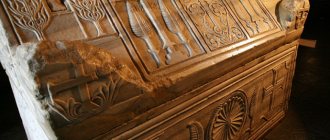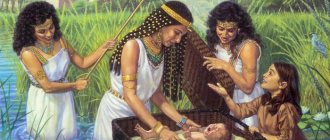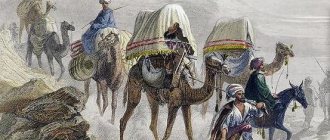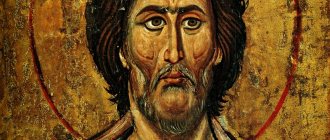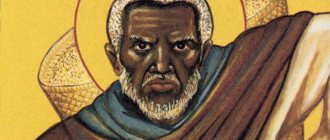What is the Pentateuch of Moses - Chumash, Torah?
Pentateuch
(
The Pentateuch of Moses
), or
“Chumash”
in Hebrew (from the word
“hamesh”
-
“five”
) - those five books of the Torah that were written down by the prophet Moses (Moshe) after the Sinai revelation, during the wanderings of the Jewish people in the desert.
Often, when they say the word “Torah”
, they mean the Pentateuch (although in a broad sense,
“Torah”
is all the Teachings and laws of Judaism). The Pentateuch is the first part of the TaNaKh and consists of five books: Bereshit (Genesis in the Russian tradition), Shemot (Exodus), Vayikra (Leviticus), Bemidbar (Numbers), Dvarim (Deuteronomy).
Since the Torah was given to Moshe Rabbeinu, Chumash has been divided into five parts - as follows from the statement of the sages in Tractate Nedarim (22 b): “If Israel had not sinned, they would have been given only five books of the Torah and the book of Joshua , because these are the books of the Land of Israel" [Yoshua Bin Nun is Joshua, the disciple and successor of Moshe Rabbeinu, and the "Book of Yehoshua" describes the conquest of the Land of Israel, which took place after the events of the last book of the Pentateuch - editor's note].
Bereshit, Shemot, Vayikra, Bemidbar, Dvarim - the books that make up Chumash
The five books of the Torah are not written in separate scrolls. One scroll is written, divided into five parts. Each part is separated from the next by four blank lines. These portions are called sifrei Torah
- “books of the Torah.”
These “books” - parts of the Pentateuch - are called by the word with which the book begins (or by one of the first words) - Bereshit, Shemot, Vayikra, Bemidbar, Dvarim. But, although the titles are given according to the first word of the book, they are deep and meaningful.
Midrash says ( Tadshe
, part 2): “In the names of all sacred books there is wisdom, and understanding, and comprehension of what is written in the book.
Why is the first book of the Torah called Bereshit
(“In the Beginning”)? Because it tells about the creation of the whole world, and it is the head of everything. And all generations will know that the Most High, blessed be He, existed before the world and by His will created the world and all its creatures, and not by the will of any of the creatures of this world, and He Himself rules the world in His glory.”
But in the books of the sages and the books of commentators of early generations we find “additional” titles for the books of the Torah. For example, the book of Bereshit is sometimes called Sefer ha-Yashar
(“Straight Book”, because most of it is occupied by the story about the forefathers - Abraham, Isaac and Yaakov - straight people. The Book of Vayikra is called
Torat Kohanim
("Charter of the Kohanim"), because most of it is devoted to the laws of the ministry of the Kohanim. The Book of Bemidbar sometimes called
Sefer Pkudim
(“Book of Numbers”) because at the beginning it talks about the numbering of the children of Israel.
LiveInternetLiveInternet
The first five books of the Old Testament, having the same author - Moses, apparently at first represented one book... from the testimony of the book. Deuteronomy, which says: “Take this book of the law and put it at the right hand of the ark of the covenant” (31:26) ...
A. P. Lopukhin. Explanatory Bible or commentary on all books of the Holy Scriptures of the Old and New Testaments:
“... Our modern word “ Pentateuch ” represents a literal translation of the Greek - πεντάτευχος from πέντε - “five” and τεύχος - “volume of the book”... Each of the five volumes of the Pentateuch has its own differences and corresponds to different periods of theocratic legislation. Thus, the first volume is, as it were, a historical introduction to it, and the last serves as an obvious repetition of the law; the three intermediate volumes contain the gradual development of theocracy, timed to certain historical facts, and the middle of these three books (Leviticus), sharply different from the previous and subsequent ones (almost complete absence of the historical part), is an excellent line separating them.
All five parts of the Pentateuch have now acquired the meaning of special books and have their own names, which in the Hebrew Bible depend on their initial words, and in Greek, Latin and Slavic-Russian - on the main subject of their content.”
“Composition of the Pentateuch
- Commandments, Laws, Statutes, Historical Sections. Initially, the books of the Torah were named after their first words. Genesis (Heb. Beresh'it - In the beginning; Greek G'enesis - Origin).
Exodus (Heb. Ve ele shem'ot - And these names; Greek Ex'odos).
Levite (Hebrew: Vayikra - And called; Greek: Levitik`on).
Numbers (Hebrew: Vaidav'ar - And said; Greek: Arhythm'oi).
Deuteronomy (Heb. El'e hadvar'im - These words; Greek. Deutoron'omion) " (A. Men).
A. Lopukhin: “The Book of Genesis contains a narrative about the origin of the world and man, a universal introduction to the history of mankind, the election and education of the Jewish people in the person of its patriarchs - Abraham, Isaac and Jacob. Book The Exodus tells at length about the exit of the Jews from Egypt and the granting of the Sinai legislation. Book Leviticus is especially devoted to the exposition of this law in all its particulars that are most closely related to worship and the Levites. Book Numbers gives the history of wanderings in the desert and the number of Jews who were counted at that time. Finally, the book. Deuteronomy contains a repetition of the Law of Moses.
Due to the fundamental importance of the Pentateuch, St. Gregory of Nazianzen called it the true “ocean of theology .” Indeed, it represents the main foundation of the entire Old Testament, on which all its other books rest. Serving as the basis of Old Testament history, the Pentateuch is the basis of New Testament history , since it reveals to us the plan of the divine economy of our salvation. That is why Christ himself said that He came to fulfill, and not to destroy, the law and the prophets (Matthew 5:17). In the Old Testament, the Pentateuch occupies exactly the same position as the Gospel in the New.”
A. Men. Isagogy of the Old Testament: selected quotes from the book:
"Five Scrolls" ... first found in the Epistle of Aristaeus (c. 200 BC) ... In Heb. traditions of P. is called the Torah, which in European languages is usually rendered with the word “law”…. “instruction”, “command”, “teaching”... Not later than the period of the Second Temple, the Torah began to be called “Moses’” (2 Chronicles 30:16; Nehemiah 8:1), although the name of Moses is not in the titles of its books (and the collection as a whole) and it does not follow from the text itself that Moses was the author of all P. On the contrary, the description of the death of the prophet and a number of features of the Torah indicate that divinely inspired writers participated in its composition. In a number of places the P., however, it is said that Moses was the author of a certain part of its narrative and legislative sections (for example, Exodus 17:14; 24: 3-4; Num 33:2; Deut 27: 1-3; 31: 9 Etc.)… From the Bible itself one can trace how P.’s authority gradually increased over the centuries. It is estimated that it is mentioned 5 times in the prophets, 8 times in the Psalms, 12 times in the Book of Kings, and 31 times in the Chronicler’s writings. NZ contains approx. 80 direct links to P.; Moreover, the word “law” itself is often used there as a synonym for all the books of the OT (for example, Rom 10:4). The significance of the law is determined by the fact that it contains the first statement of the fundamental foundations of biblical revelation, faith and theology. The books of Moses: 1) proclaim faith in the one true God, Creator and Provider; 2) they talk about the covenant between God and man and the violation of this covenant by people; 3) talk about the beginning of the Church, the people of God; 4) contain the religious and moral principles of life of the community of the faithful; 5) profess faith in the manifestation of the will of the Lord through the events of history; 6) teach about the divine-human character of history itself; 7) proclaim the soteriological acts of the Lord (promise, messianism). All the main traditions of the Old Testament schools and movements (prophets, priests, sages, psalmists) genetically derive from P. The symbolism of P. permeates the NT...
1. Why the Covenant was given within one nation
. The books of Holy Scripture
were not created by one of the famous and powerful civilizations,
but were a Revelation
given to a people living in a small and poor country, whose history is a chain of severe trials, crises and adversities.
But it was there that the spiritual threshold and prototype of the Church of Christ was located. In the Old Testament, the Church, or the People of God, was limited to national boundaries. This is due to the fact that in ancient times the transmission of any spiritual tradition was carried out from parents to children, within the bosom of a certain culture and national tradition.
This stage began to be overcome in the Hellenistic era (III-I centuries BC), when the first proselytes began to enter the Old Testament Church. The New Testament Church already embraces Jews and Greeks, barbarians and Scythians (Col. 3:11), becoming the new universal people of God.
2. Patriarchs and oral legends. The ancestors of the Israelites, called patriarchs, came to Palestine from the East, from Mesopotamia and Syria. Their migration was associated with a calling from above, which prompted Abraham to leave his “father’s house.” At this time (c. 1900-1700 BC) the first legends about the beginning of the world and man, as well as legends about the patriarchs themselves (Abraham, Isaac, Jacob, Joseph, etc.) were apparently composed. ). This tradition was consolidated in oral
form.
Chronological milestones in the history of the Old Testament Church (The period described in the Pentateuch)
| OK. 1850 | — Abraham, Isaac |
| OK.1700 | — Jacob |
| OK.1650 | — Joseph, Israel's migration to Egypt |
| XIII century, second half | - exodus from Egypt |
3. From Moses to Joshua. At the beginning of the XV II century BC. the Israelites (Children of Israel) migrated
during a famine in the border region of the Nile Delta.
This happened under the Asian Hyksos pharaohs
, who patronized people from Palestine.
But under the pharaohs of the New Kingdom,
their situation worsened.
Some groups of the Sons of Israel left Egypt
(there are hints of this in Joshua 8:33; 1 Chron 7:21,24).
Life became especially difficult for the Israelis under Ramses II
, who, having moved his residence to the Delta, attracted foreigners to construction work.
In the 13th century, Israel left Egypt under the leadership of the Levite Moses, who became its leader, prophet and lawgiver. At first, the people wandered through the desert in the vicinity of Mount Sinai and the oasis of Kadesh. There, God, through Moses, gave the first Law, from which the Holy Tradition of the Torah (Pentateuch) originates.
Part of it was written down by Moses himself (for example, Exodus 20), part of it was kept orally among the Levites.
Nevertheless, in spirit the Torah remains Mosaic
. In the same era, hymns were composed (Exodus 15; 16:17; Numbers 10:35), which were included in collections that have not survived to our time...”
The author of the book of Genesis
is A. Lopukhin:
“... a compelling argument for the authenticity of the Pentateuch is the universal tradition, which has been continuous for a number of centuries, starting with the book of Joshua (1:7-8; 8:31; 23:6, etc.) , going through all the other books and ending with the testimony of the Lord Jesus Christ himself (Mark 10:5; Matt. 19:7; Luke 24:27; John 5:45-46), unanimously asserts that the writer of the Pentateuch was the prophet Moses . The testimony of the Samaritan Pentateuch and ancient Egyptian monuments should also be added here.” A. Men: “The Pentateuch nowhere contains direct indications that it entirely belongs to Moses. It only mentions the “book” where he recorded memorable events (Exodus 17:14; Numbers 33:2), and also wrote down laws and commandments (Exodus 24:4; 34:27). However, there are passages in the Pentateuch that clearly date back to the time after Moses.
Thus, speaking about the arrival of Abraham in the vicinity of Shechem, the writer of everyday life notes: “The Canaanites lived in this land at that time” (Gen. 12:6).
Consequently, Israelites were already living there in his time. Genesis 14:14 mentions the city (or area) of Dan, which received its name after the tribe of Dan moved to Canaan under Joshua. In Genesis 36:31 it is said about the kings of Edom that they reigned “before the reign of kings among the children of Israel,” - thus, St. the writer already knows about these kings (and they appeared 200 years after Moses). Further, the prophet himself is spoken of in such a reverent tone that these words can hardly be attributed to him (Numbers 12:3; Deut 33:1; 34:10-11). And, finally, it is impossible to assume that Moses spoke about his own death (Deut. 34)... Echoes of later times also lie in such places in Exodus as the description of the tabernacle (25.31 - 27.8). It hardly corresponds to the poor nomadic life of the Israelis... All this led biblical theologians to the conclusion that
only part of the text of the Pentateuch belongs directly to the prophet, the rest is the Mosaic Tradition, set out in writing by other divinely inspired sages ...
Variations in biblical stories - “variations can be traced in the ways of revealing a particular topic within the Pentateuch. For example:
a) the creation stories in Gen. 1-2, while united in spirit, are clearly different in character (in Gen. 1, plants and animals were created first, and then man; according to Gen. 2, when man appeared, there were no plants yet, and animals were created after person);
b) in Gen. 4:25-26 the birth of Seth is narrated, and in Gen. 5:3 this is spoken of as if for the first time;
c) in Gen. 4.17 Enoch is the son of Cain, and in Gen. 5.18 – the son of Jared, i.e. tenth after Adam;
d) in Gen. 7.17 the flood (flood) lasted 40 days, and in Gen. 7.24 – 150 days.
These discrepancies (the number of which are very large) allow us to identify four lines in the sacred narrative
, which are woven into one whole.
Many biblical scholars believe that there were originally four coherent texts that arose at different times and in different circles
" ...
Each story corresponds to one of the legislative texts of the Torah.
| Traditions of the Pentateuch | Corresponding laws and statutes |
| Yahwistic | Ritual Decalogue (Exodus 34) |
| Elohistic | Decalogue, or Ten Commandments (Exodus 20:2-17) Book of the Covenant (Exodus 20:22 – 23:33) |
| Priestly | Leviticus and the statutes of Numbers (Numbers 5-10; 18-19) |
| Deuteronomy | The legislative part of Deuteronomy with the inclusion of the Decalogue in a slightly modified form |
The historical environment of pre-Mosaic and Mosaic times
is described with such reliability that it excludes the idea that the legends of the Pentateuch were invented by authors of the 10th or 8th centuries. In other words, the Books of Moses are a record of a very ancient, authentic Tradition.
... the four sources of P. were not “composed”, but were a “crystallization” of the Mosaic Tradition. It was consolidated and recorded in stages: at Sinai, in Kadesh, in Transjordan, and under Joshua - in Shechem (cf. the rite described in Deut. 27-28) ... As for the liturgical regulations of Leo, they go back to ancient times, right up to the times who preceded Moses. They were passed down by the clergy over the centuries in oral and written tradition and took their completed form during the period of captivity. At the end of this period, an unknown priest. the writer (maybe, Ezra?) gathered the entire corpus of P. together... Thus, in the history of the formation of P., a living, uninterrupted continuity of the Mosaic Tradition can be traced. His most important theological concepts, such as monotheism, revelation, covenant, promise, etc., determine the spiritual unity of P., and therefore it is rightfully associated by church tradition with the name of this great leader and prophet.
Question about the time of Moses' life.
In P. there are no direct dates or indications of historical figures contemporary with Moses (the Egyptian kings are simply called “pharaohs”).
The chronology, which can be inferred from the text of the Bible itself, is based on the date in 1 Kings 6:1, which says that the Temple began to be built 480 years after the exodus. And since Solomon began building the Temple ca. 968 , then the life of Moses should be attributed to the middle of the 15th century. BC But there is a serious chronological objection here. Exodus 1:11 says that the oppressed Israelites built the city of Rameses for Pharaoh ; Meanwhile, in the 15th century. this city was still in ruins and did not bear the name Ramses (its former name was Hetvart, Greek Avaris). It was revived by Pharaoh Ramesses II (c. 1290-1224 ), who moved his residence there. Therefore, biblical scholars view the number 480 as a symbolic number (40x12). The stela of Pharaoh Merneptah discovered by Petrie raised new questions. It dates from ca. 1220 and mentions Israel as a tribe already living in Canaan (or on its border). Currently, there are three options for solving the problem: 1) Merneptah meant the Israelites who left Egypt before Moses (we find a hint of this in 1 Chron 7: 21-24, which talks about the invasion of Canaan by the sons of Ephraim); 2) the stele displays events related to the exodus (Ramesses is the oppressor pharaoh, and his son Merneptah is the pharaoh of the exodus); 3) the exodus occurred under Ramses II, and the stele indicates the appearance of the Israelis in Palestine. The latter point of view was substantiated in detail by Albright (1938)...
The Old Testament Church did not know the division into God and worldliness . Human life in all its manifestations had to pass before the face of the Lord. Therefore, the Pentateuch, along with religious and moral commandments, includes civil and criminal law.
The entire body of legislation came from God and was traditionally sanctified by the authority of Moses.
It was Moses, as the creator of the Old Testament Church, who set before it the task of serving God and belonging only to Him. It was through him that God revealed to people that adherence to moral principles is the most important duty of a believer.
The gradual enrichment and expansion of the Mosaic Law captured more and more new areas of human life, work, marriage and social relations. “Life according to the Law” did not simply mean the mechanical fulfillment of a certain sum of instructions, but brought every step of a person into accordance with the will of God. This spiritual depth of the “religion of the Torah” is reflected in the Psalter, especially Ps 118, read by the Church at funeral services. But the desire of believers to subordinate every detail of life to the rules of the law was also fraught with dangers. Gradually it began to turn into deadening statutory piety, complex casuistic morality, religious formalism and ritualism. This is the source of legalism , which later turned out to be an obstacle to the gospel of Christ's freedom. The conviction that man can achieve righteousness through his own efforts created that type of “hypocrite” who was severely condemned by Christ the Savior...
The prophecies about Christ in P. The books of Moses are characterized by a certain incompleteness, for they are imbued with the expectation of a great and mysterious future, the meaning of which is not fully revealed. Already in Genesis 3:15, the Fathers of the Church saw a prophecy about the final victory over the Serpent. In the appearance of the God-man, the secret of the prophecy given to Abraham is revealed, that in him (i.e. in his descendants) all the families of the earth will be blessed (Gen. 12:3; cf. 18:18; 22:18; 26:4). This same prophecy is confirmed in the revelation to Jacob (Gen. 28:14). messianic significance (Numbers 24:17). Moses predicts the appearance of the eschatological Prophet, through whom God will speak to people. “And the Lord said to me: ... I will raise up for them a prophet like you from among their brothers, and I will put My words in His mouth, and He will speak to them whatever I command Him” (Deut. 18:18; cf. 18: 15)… In a later age He will be expected not only as a Prophet, but also as a King and as a High Priest.”
What is the Bible
The Bible is the Holy Book of Christians. It consists of the Old Testament and the New Testament, the basis for which was the Torah or Pentateuch. The Old Testament tells the story of God's ancient people, the Jews, Genesis, their trials and the promise of the Messiah. The New Testament talks about the life and death of Jesus Christ. All this was written down by four of the twelve apostles.
The first language into which the Bible was translated was Greek, which is why it got its name from the Greek word for book, bible. During the translation, some ancient sages, unrelated to each other, made some changes.
Later it was translated into Latin, where it was also corrected. When the Protestant Reformation began, the Holy Book of the Bible was translated into other languages. Since only educated people - nobles - knew Latin, it was difficult for the poor people who attended services to understand what the priest was saying. The Bible is read in church during rites and ceremonies, but Christians can also keep it for reading in their homes.
Some denominations of Christianity recommend interpreting the Bible at home on your own, while others, in turn, condemn this practice. They claim that this should be done by clergy specially trained to read and spread the word of God.
Introduction to the Pentateuch
Each book represents a separate state, but at the same time they all form a certain union. And theological themes run through them as a red thread.
Task No. 1: Create a world.
The narrative structure of the Pentateuch: Creation - Fall - Promise; Covenant - Test - Fulfillment of Promise; Salvation of the people - Sin of the people - Fulfillment of the Promise, or the path leading from Adam to Noah, from Noah to Abraham, from Abraham to Moses).
This structure can serve as a basis for writing good drama.
The Pentateuch of Moses includes the following books:
1) Genesis;
includes the Prologue (it talks about the creation of the world and man) and tales of the patriarchs;
2) Outcome;
a book dedicated to the liberation of God's people from slavery under the leadership of Moses;
3) Leviticus;
liturgical regulations of the Old Testament Church;
4) Numbers;
the book describes the wanderings of the Israelites in the Sinai desert and the beginning of their penetration into Canaan;
5) Deuteronomy
the book contains the dying laws of Moses, which were announced to the people in eastern Palestine, and the story itself about the death of the apostle.
Literary character
In this collection there is a certain play of various genres, which in no way violate the substantive and ideological unity of the books. In the Pentateuch, sections written in a purely chronicle manner and chapters filled with drama and emotion resonate; lists of names, peoples, cities and countries stand alongside epic stories and hymns.
Bright elements do not violate the integrity of the Bible
The language of the Pentateuch goes back to ancient times; but along with archaisms, it also has much in common with the classical language of the prophet-writers (especially Deuteronomy).
In the literary fabric of the collection, 8 main genre types can be distinguished.
a) Poetic fragments and hymns
(Judgment of God, Gen. 3:14-19; Song of Lamech, Gen. 4:23-24; *Song of Miriam, Ex. 15, etc.).
b) Prophetic stories in poetic form
(Blessing of Jacob, Gen. 49:1-27; words of Balaam, Num. 23:7 ff.; Song of Moses, Deut. 32, etc.).
c) Legislative sections, exhortations, religious and ethical norms, blessings and curses.
d) Liturgical regulations
(Ex, Lev, Num, Deut).
e) Genealogies and similar geographical and ethnographic lists (eg, Gen. 5:1-32). These sections are the frame of the story. They emphasize the historicism of the Pentateuch.
f) Historical and symbolic tales that reveal the essence of ancient history, or the metahistory of the beginning of humanity.
g) Epic tales of the patriarchs, the Exodus and the migration to Canaan, in which the past is often given through the narration of a sacred legend.
h) Edifying tales, close in spirit to the writings of the sages.


